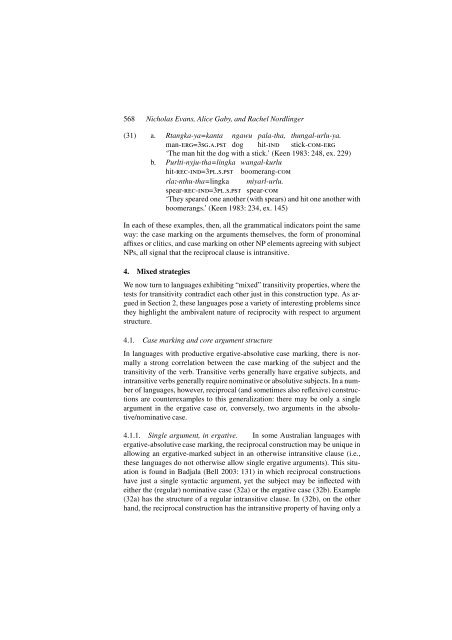Valency mismatches and the coding of reciprocity in ... - Linguistics
Valency mismatches and the coding of reciprocity in ... - Linguistics
Valency mismatches and the coding of reciprocity in ... - Linguistics
You also want an ePaper? Increase the reach of your titles
YUMPU automatically turns print PDFs into web optimized ePapers that Google loves.
568 Nicholas Evans, Alice Gaby, <strong>and</strong> Rachel Nordl<strong>in</strong>ger<br />
(31) a. Rtangka-ya=kanta ngawu pala-tha, thungal-urlu-ya.<br />
man-erg=3sg.a.pst dog hit-<strong>in</strong>d stick-com-erg<br />
‘The man hit <strong>the</strong> dog with a stick.’ (Keen 1983: 248, ex. 229)<br />
b. Purlti-nyju-tha=l<strong>in</strong>gka wangal-kurlu<br />
hit-rec-<strong>in</strong>d=3pl.s.pst boomerang-com<br />
rla:-nthu-tha=l<strong>in</strong>gka miyarl-urlu.<br />
spear-rec-<strong>in</strong>d=3pl.s.pst spear-com<br />
‘They speared one ano<strong>the</strong>r (with spears) <strong>and</strong> hit one ano<strong>the</strong>r with<br />
boomerangs.’ (Keen 1983: 234, ex. 145)<br />
In each <strong>of</strong> <strong>the</strong>se examples, <strong>the</strong>n, all <strong>the</strong> grammatical <strong>in</strong>dicators po<strong>in</strong>t <strong>the</strong> same<br />
way: <strong>the</strong> case mark<strong>in</strong>g on <strong>the</strong> arguments <strong>the</strong>mselves, <strong>the</strong> form <strong>of</strong> pronom<strong>in</strong>al<br />
affixes or clitics, <strong>and</strong> case mark<strong>in</strong>g on o<strong>the</strong>r NP elements agree<strong>in</strong>g with subject<br />
NPs, all signal that <strong>the</strong> reciprocal clause is <strong>in</strong>transitive.<br />
4. Mixed strategies<br />
We now turn to languages exhibit<strong>in</strong>g “mixed” transitivity properties, where <strong>the</strong><br />
tests for transitivity contradict each o<strong>the</strong>r just <strong>in</strong> this construction type. As argued<br />
<strong>in</strong> Section 2, <strong>the</strong>se languages pose a variety <strong>of</strong> <strong>in</strong>terest<strong>in</strong>g problems s<strong>in</strong>ce<br />
<strong>the</strong>y highlight <strong>the</strong> ambivalent nature <strong>of</strong> <strong>reciprocity</strong> with respect to argument<br />
structure.<br />
4.1. Case mark<strong>in</strong>g <strong>and</strong> core argument structure<br />
In languages with productive ergative-absolutive case mark<strong>in</strong>g, <strong>the</strong>re is normally<br />
a strong correlation between <strong>the</strong> case mark<strong>in</strong>g <strong>of</strong> <strong>the</strong> subject <strong>and</strong> <strong>the</strong><br />
transitivity <strong>of</strong> <strong>the</strong> verb. Transitive verbs generally have ergative subjects, <strong>and</strong><br />
<strong>in</strong>transitive verbs generally require nom<strong>in</strong>ative or absolutive subjects. In a number<br />
<strong>of</strong> languages, however, reciprocal (<strong>and</strong> sometimes also reflexive) constructions<br />
are counterexamples to this generalization: <strong>the</strong>re may be only a s<strong>in</strong>gle<br />
argument <strong>in</strong> <strong>the</strong> ergative case or, conversely, two arguments <strong>in</strong> <strong>the</strong> absolutive/nom<strong>in</strong>ative<br />
case.<br />
4.1.1. S<strong>in</strong>gle argument, <strong>in</strong> ergative. In some Australian languages with<br />
ergative-absolutive case mark<strong>in</strong>g, <strong>the</strong> reciprocal construction may be unique <strong>in</strong><br />
allow<strong>in</strong>g an ergative-marked subject <strong>in</strong> an o<strong>the</strong>rwise <strong>in</strong>transitive clause (i.e.,<br />
<strong>the</strong>se languages do not o<strong>the</strong>rwise allow s<strong>in</strong>gle ergative arguments). This situation<br />
is found <strong>in</strong> Badjala (Bell 2003: 131) <strong>in</strong> which reciprocal constructions<br />
have just a s<strong>in</strong>gle syntactic argument, yet <strong>the</strong> subject may be <strong>in</strong>flected with<br />
ei<strong>the</strong>r <strong>the</strong> (regular) nom<strong>in</strong>ative case (32a) or <strong>the</strong> ergative case (32b). Example<br />
(32a) has <strong>the</strong> structure <strong>of</strong> a regular <strong>in</strong>transitive clause. In (32b), on <strong>the</strong> o<strong>the</strong>r<br />
h<strong>and</strong>, <strong>the</strong> reciprocal construction has <strong>the</strong> <strong>in</strong>transitive property <strong>of</strong> hav<strong>in</strong>g only a

















